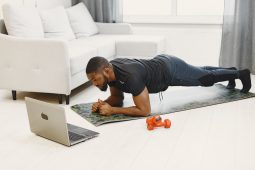Core Strength in Fitness
When we think about fitness, many of us focus on building muscles, improving cardiovascular health, or increasing flexibility. But one often overlooked aspect of overall fitness is core strength. Core strength is the foundation for nearly every movement we make, both in exercise and in daily activities. From bending to picking up objects to running or swimming, your core plays a significant role. Let’s explore the importance of core strength and how you can work toward developing a stronger, more stable core.
What Is Core Strength?
The “core” refers to the group of muscles in your abdomen, lower back, hips, and pelvis. These muscles work together to support your spine, help maintain good posture, and provide stability during movements. In essence, your core is the powerhouse that enables you to perform both functional and athletic movements effectively.
The primary muscles that make up your core include:
-
Rectus abdominis: Often referred to as the “six-pack” muscles, these are responsible for flexing the spine.
-
Obliques: Located on the sides of your torso, these muscles help with rotation and lateral movements.
-
Transverse abdominis: This is the deep muscle layer responsible for stabilizing your core.
-
Erector spinae: A group of muscles that run along your spine and help with extending your back.
-
Pelvic floor muscles: These help with bladder control and overall pelvic stability.
For more information on different core exercises, check out this comprehensive guide on strengthening your core.
Why Is Core Strength Important?
-
Improves Posture A strong core supports proper alignment of the spine and pelvis, which is key to maintaining good posture. When your core muscles are weak, you may find yourself slouching or having difficulty standing up straight, which can lead to back pain and discomfort. Strengthening your core helps you sit and stand with better posture throughout the day, reducing the strain on your back and neck.
Learn more about the benefits of improving your posture here.
-
Enhances Athletic Performance No matter the sport, your core is essential for performance. Whether you’re running, cycling, swimming, or playing tennis, a strong core allows for better stability and control. It also helps improve balance, coordination, and power transfer from the lower body to the upper body and vice versa. Core strength is particularly important for athletes involved in activities that require rotational movements, like golfing or boxing.
Discover how core strength can improve your performance in various sports by visiting this article.
-
Prevents Injuries A weak core can lead to poor movement patterns, which may put excess stress on other parts of the body, particularly the lower back. By building core strength, you’re protecting your spine and reducing the risk of injuries during physical activities. A strong core also helps you maintain stability during movements, reducing the likelihood of falls or strains.
Learn about injury prevention strategies here.
-
Supports Daily Functioning Beyond fitness and sport, your core plays a crucial role in everyday tasks. From bending over to pick something up to lifting heavy groceries or children, your core is actively engaged. A strong core helps make these activities more efficient and less likely to lead to injury.
How to Build Core Strength
Building core strength doesn’t require complicated exercises or expensive equipment. There are plenty of bodyweight exercises that target your core muscles and can be done from the comfort of your home. Here are a few effective exercises:
-
Plank The plank is one of the best exercises for building overall core strength. Begin by getting into a push-up position with your forearms on the ground and your body in a straight line from head to heels. Hold this position for 30 seconds to a minute, engaging your core throughout.
Check out more variations of the plank here.
-
Dead Bug The dead bug is great for improving stability and engaging the deep core muscles. Lie on your back with your arms extended toward the ceiling and your knees bent at 90 degrees. Slowly lower your right arm and left leg toward the floor while keeping your lower back pressed into the ground. Return to the starting position and repeat on the other side.
-
Russian Twists Sit on the floor with your knees bent and feet flat. Lean back slightly and hold your hands together in front of you. Rotate your torso to the left, then to the right, while engaging your obliques. For an added challenge, hold a weight or medicine ball as you twist.
-
Bird Dog Start on your hands and knees with your wrists directly under your shoulders and your knees under your hips. Extend your right arm forward and your left leg backward, keeping your body in a straight line. Hold for a few seconds, then switch sides. This exercise improves balance and engages both the front and back of your core.
-
Leg Raises Lie on your back with your legs straight and your arms by your sides. Slowly raise your legs until they’re perpendicular to the floor, then lower them back down without letting them touch the ground. This exercise targets the lower abs and helps to build core strength.
For a full breakdown of each exercise, head over to this complete guide.
Tips for Effective Core Training
-
Focus on form: Proper form is essential when performing core exercises to prevent injury and maximize effectiveness.
-
Engage your core: For every core exercise, focus on actively engaging your core muscles. Think about drawing your belly button toward your spine and keeping your lower back protected.
-
Consistency is key: Like any fitness goal, building core strength takes time. Aim to include core exercises 2-3 times per week as part of a well-rounded fitness routine.
-
Progress gradually: Start with easier exercises and work your way up to more challenging ones as your strength improves.
Conclusion
Core Strength in Fitness is a vital component of any fitness routine, and it provides a solid foundation for all types of movement. Whether you’re looking to enhance athletic performance, prevent injury, or simply improve your posture and daily functionality, strengthening your core will benefit you in countless ways. Incorporate these exercises into your routine and stay consistent, and you’ll notice significant improvements in both your fitness and overall health.
Remember, a strong core is the key to unlocking your body’s full potential—so start strengthening today!
















